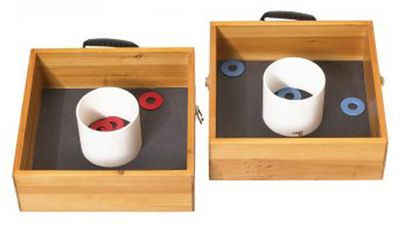Newest lawn games have a familiar feel

Now that summer is officially here, let us turn our attention to lawn games.
And we don’t mean croquet, which requires the purchase of an actual set, or volleyball, which requires physical exertion.
Classically, a lawn game is assembled at home, preferably with things you already have, and can be played without ever putting down your beer or burger.
Boredom and lack of money are the mothers of invention when it comes to lawn games. Got some horseshoes lying around? Let’s toss them at that stake. A can? Let’s kick it around.
In this economy, if ever there were a summer for lawn games to thrive, this is it.
People still play the classics, such as horseshoes, but fewer people have horses, or horseshoes. Hence a new breed has arrived to maintain the “let’s-toss-random-things-at-other- random-things” tradition.
Golf balls, bags of cornmeal and oversize washers are the new lawn-game implements. You can buy sets for most of these games, but you can assemble your own variations at little or no cost.
One of the newest games is Ladder Ball, which originated in the Midwest a few years ago. It also goes by Ladder Toss, Blongo Ball and Bolo Toss.
You can buy a version of it called Ladder Golf in stores for $60. But with some PVC pipe, 12 golf balls and string, you can make one for less. Numerous Web sites offer instructions for building your own set, including www.outdoorgameplayers.com/ ladder-golf-game.html.
There are six “bolos” – two golf balls tied together with string (get balls with solid centers instead of liquid cores, because you have to drill a hole in each ball) – and two “ladders,” which really look like gates made of pipes.
Each ladder has three rungs and is about 3 feet high, 2 feet wide. They are placed about 20 feet from each other. Bolos should be about 18 inches long; use a different color of golf ball for each team.
Both teams stand at one of the ladders and try to toss the bolos at the other. You can create your own scoring system (there’s some debate within the Ladder Toss community about whether the top or bottom rungs are more difficult). You also can try to knock opponents’ bolos off the rungs, denying them points.
Players get three throws per round, and scores generally go up to either 15 or 21.
Again in the Midwest, where these games seem to proliferate, tailgaters and barbecuers have taken to Corn Toss, also known as Cornhole. The game recently was featured on “The Colbert Report” (and, yes, Stephen Colbert did make fun of the name).
We couldn’t find any sets in stores, but no worry – it basically amounts to tossing small bags of cornmeal, and you can make them at home (beanbags work, too).
Players throw them at a raised large piece of plywood with a hole in it. The object is to throw the most bags in the hole. Keeping with the lawn-game tradition, scoring is pretty loose.
Another popular entrant in the lawn-game genre is Washer Toss, in which players throw 2-inch-diameter washers at cups sunken into wooden boards.
According to the Washer Pitching Association, you get 5 points for tossing a washer into a cup, 3 if it’s hanging over the side of the cup and 1 point for being closer than any of the others. Again, scoring policies are loose.
We saw a University of Connecticut Huskies version of this game online retailing for $65, but that seems way more than anyone should spend on washers and cups.